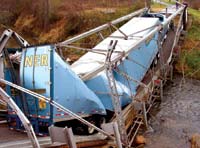With an overflow crowd in attendance on Aug. 21, City Council approved stronger rules to protect wetlands, streams and rivers from construction-related runoff, to bring the city into compliance with federal storm-water guidelines.
Although city staff and some stakeholders called for a 50-foot development-free buffer along streams, Council members demurred in the face of opposition from many of the more than 20 residents who rose to speak on the issue. Instead, Council increased the city’s current 20-foot buffer to 30 feet, in line with a new state minimum requirement. But Council members did agree to consider adopting a bigger buffer in a few weeks, after staff and the city’s Planning and Zoning Commission address concerns raised by property owners, developers and affordable-housing advocates.
Transportation and Engineering Director Cathy Ball and her staff explained that a 50-foot buffer would comprise about 2,500 acres of land along the city’s 200 miles of streams, as opposed to 1,500 acres for a 30-foot buffer. The rules, which cover any stream included on a U.S. Geological Survey topographical map, also apply to other bodies of water, such as lakes and permanent wetlands. Supporters pointed out that the 50-foot buffer recommended by staff is already in place in several North Carolina municipalities and counties. A few have adopted even tougher standards. Charlotte has a 100-foot buffer, noted Mountain Voices Alliance spokesperson Heather Rayburn.
ACLU, city settle lawsuit
by David Forbes
The Asheville City Council’s Aug. 21 vote to modify the city’s parade ordinance was unanimous and drew no comment. But while it lacked the furor surrounding many other matters that come before Council, the action did put to rest a lawsuit against the city filed by the American Civil Liberties Union of North Carolina and an immigration-reform group. The suit maintained that the city had charged excessive fees for a protest permit last year. The city also agreed to refund the disputed fees.

The very next day, the ACLU announced that it would ask a judge to dismiss the lawsuit. The groups maintained that the city had charged the May 1st We Are One America Committee $1,500 in connection with a protest held in downtown Asheville on May 1, 2006—including charging for some services the group had never requested.
The retooled ordinance specifies that “the fees the city charges are for services that are requested by the organizers and are necessary to protect public safety.” The law also allows fees to be waived or reduced “if the organizers are demonstrably indigent, or as necessary to ensure that constitutional rights are not infringed.”
The May 1st group had informed the city at the time that it could not pay the fees. The peaceful demonstration drew about 3,500 people.
“We’re thrilled,” spokesperson Althea Gonzalez told Xpress. “We’re glad the city and the police were able to get this resolved and see that people have the right to protest without being charged exorbitant fees. We’ve had a good relationship with the police before this, and we look forward to continuing that in the future.”
The ACLU, meanwhile, released a similarly upbeat statement quoting staff attorney Katy Parker, who said, “People’s ability to exercise their constitutional rights to freedom of speech in America should not be contingent upon their ability to pay exorbitant, unnecessary fees.”
In a joint statement, the city and the May 1st Committee both expressed satisfaction with the outcome. “The amendments to the parade ordinance recently approved by City Council will improve the law’s clarity, for the benefit of both the police and the public,” the statement notes. “They accommodate our common interest in public safety while preserving the right of free expression for all persons.”
Although many speakers decried the impacts of runoff from construction sites on private property and local waterways, many others maintained that going above and beyond the rules required by the state constitutes a “taking of property without compensation” and thus violates their rights. And many of those opposed to tougher rules placed much of the blame for current runoff on the city, which they said has failed to enforce existing rules and to upgrade its antiquated storm-water system.
Advocates of the staff recommendations agreed that this is a property-rights issue—namely the right not to have one’s property inundated by silt, stones and water (see “Rivers of Mud,” Aug. 8 Xpress). Spring Cove Road resident James Hildebrandt said runoff from construction sites in his north Asheville neighborhood frequently turns his and his neighbors’ properties into a “chocolate fountain.”
Although the city had been drawing up the rules in consultation with various business, development and environmental stakeholder groups, several speakers complained that the ordinance had been rushed through with scant public input. Despite four public meetings held over the past two months, several aggrieved property owners said they’d only recently learned about the proposed changes.
“It seems every time I view the ordinance it opens up new and unanswered questions,” said Asheville resident Carl Kuhn, adding that the ordinance was “hard to read and understand.”
Asheville resident and local developer Jerry Sternberg said not enough time had been devoted to crafting the ordinance and explaining the ramifications of the changes to property owners. He argued that the regulations should go back to the Planning and Zoning Commission for more public hearings.
Critics said the draft ordinance was unclear about what activities might be exempted from the tougher rules, and which proposed regulations differed from state guidelines. In some cases, the city ordinance goes beyond state guidelines or creates new regulations where the state has none. For example, state rules require ground cover to be planted within 21 days of the completion of construction; the city’s ordinance has decreased that time to 14 days. Moreover, the new ordinance includes slope-stability requirements not included in the state’s rules.
A handful of lawyers said the ordinance is confusing because it combines storm-water and erosion rules. Typically, these two areas are treated separately, but city staff suggested combining them in the hopes of making the requirements “more consistent and user-friendly,” according to a staff report.
Several developers told Council members that the new ordinance would greatly increase development costs if it included a 50-foot buffer. And Cindy Weeks of Mountain Housing Opportunities warned that going beyond what the state mandates would make it even harder to build affordable housing here, and that a 50-foot buffer would negatively impact several mixed-use projects the nonprofit has either under way or planned in the River Arts District along the French Broad River. Another resident argued that overly stringent regulation would further “marginalize” those who need affordable housing in a high-priced market where few such options are available.
Against this background, a motion by Council member Bryan Freeborn to pass the regulations recommended by staff failed for lack of a second. But in a subsequent 5-2 vote, with Council member Carl Mumpower and Vice Mayor Holly Jones opposed, Council agreed to adopt the ordinance with 30-foot buffer.
In opposing even a 30-foot buffer, Mumpower said the city should move incrementally, first focusing on tighter enforcement of the existing rules and addressing the problems with the city’s storm-water infrastructure.
With the vote, Council also agreed to raise the maximum fine for violations from $500 to $5,000 per day, in line with state guidelines. And in a requirement not mandated by the state, developers would also have to provide proof that they’ve retained a licensed engineer or other professional to inspect construction sites on a weekly or biweekly basis. That requirement would apply only to developments involving more than 10,000 square feet, however.
In a separate 6-1 vote, with Mumpower opposed, Council budgeted $325,000 to pay for six new enforcement officers, as well as their vehicles and computers. The money would come from the city’s general fund balance.
Despite agreeing with other Council members that the city lacks the staff to enforce even existing rules, Mumpower declined to support any aspect of the new ordinance, saying that speakers had clearly demonstrated its flaws.
“I’m as much outraged by the process as I am the final product,” Sternberg declared, adding, “I think the public shares my outrage.”
Council member Brownie Newman said he well may support a larger buffer when Council revisits the issue. But a one-size-fits-all approach may be inappropriate, he said, suggesting that Council consider buffers even larger than 50 feet in some places and smaller in others.
The state of Asheville’s bridges

Asheville’s major bridges may not have the sorts of serious problems that led to the deadly collapse of the Interstate 35 West bridge in Minneapolis recently, but many of the area’s bridges are past their prime, said city Public Works Director Mark Combs.
Council asked Combs to address the condition of the city’s bridges in light of the Minneapolis catastrophe. The last collapse of a bridge in the city came two days before Christmas in 2001 when a semi-trailer weighted down with magazines collapsed the East Oakview bridge. The bridge collapsed after the truck rolled onto the bridge, then tried to back out, breaking some of the supports.
Of the 166 bridges in the city, 131 are maintained by the state and 31 by the city. Of those, Combs said, six are rated “structurally deficient” because they cannot handle the present-day weight limit of 80,000 pounds. Another 49 are “functionally obsolete” because of weight limits and a host of other factors, including age and design.
However, Combs said, those designations do not mean the bridges are unsafe, so long as weight limits and other rules and cautions are followed. He added that “any bridge that could be dangerous to the public is repaired immediately.”
Other business
The city will expand on Dec. 31, when three areas just outside the city limits become part of Asheville. In a series of 5-2 votes, Council agreed to annex more than 850 acres in the Schenck Gateway area near Long Shoals Road, part of the Sardis Road area, and a portion of the Biltmore Lake subdivision. The latter move came despite months of protests by Biltmore Lake residents, and all three annexations were opposed by Mumpower and Freeborn, who say they object to forced annexation on principle.
Other Council members said they have little choice but to use the controversial method, which is allowed under state law, since the state has unfairly hamstrung Asheville’s ability to annex in any other way (see “Annexation Debate Claims Center Stage,” March 7 Xpress).
Council members also unanimously approved rezoning a project on Sand Hill Road from Highway Business District to Urban Village District. Main Street at Biltmore Lake will include nine buildings containing 424 residential condos as well as office and retail space.
In another unanimous vote, Council approved a conditional-use permit for a planned 105-room Value Place Hotel. The 2.9-acre site is behind the Home Depot off the Smoky Park Highway on Monte Vista Road.


Excellent reportage about County Commish and City Councl meets (with good sidebars), but wished you’d connected approval of 105-unit motel-hotel near Biltmore Village with approval of “urban village” zoning and annexation. Isn’t the intent of “urban village” that large hotels near freeway exits be located, whenever possible, near or in said villages? If Council understood what they approved in Biltmore Lake, then they should have automatically denied what they approved behind the Home Depot (too) near I-40.